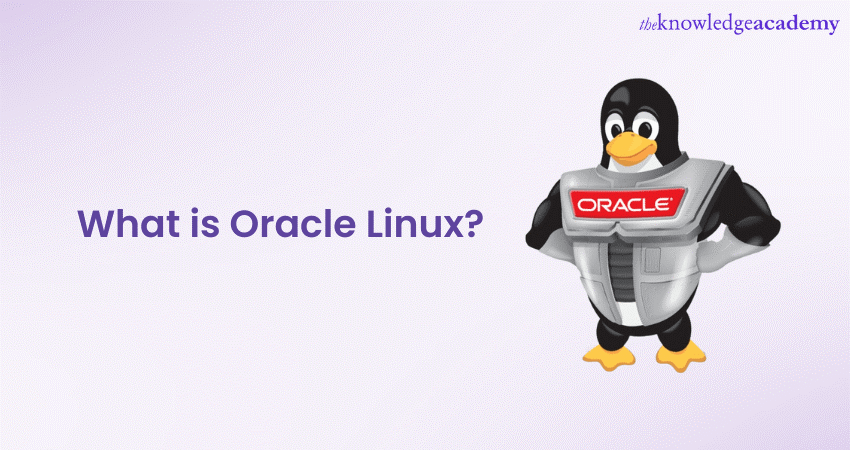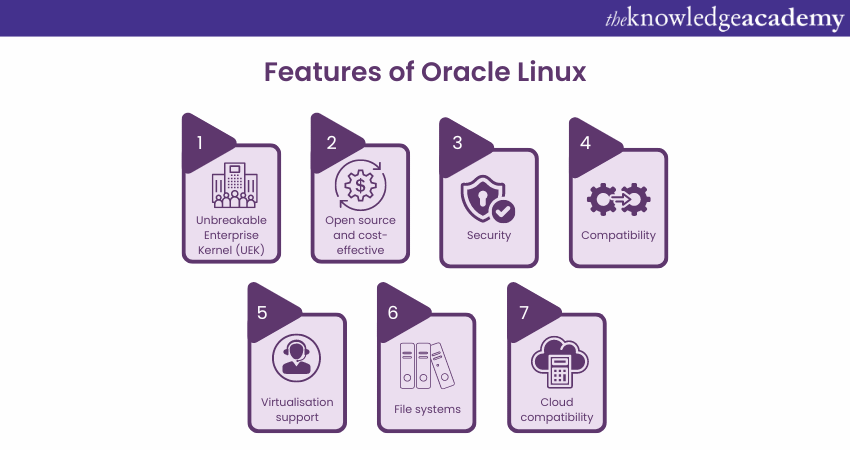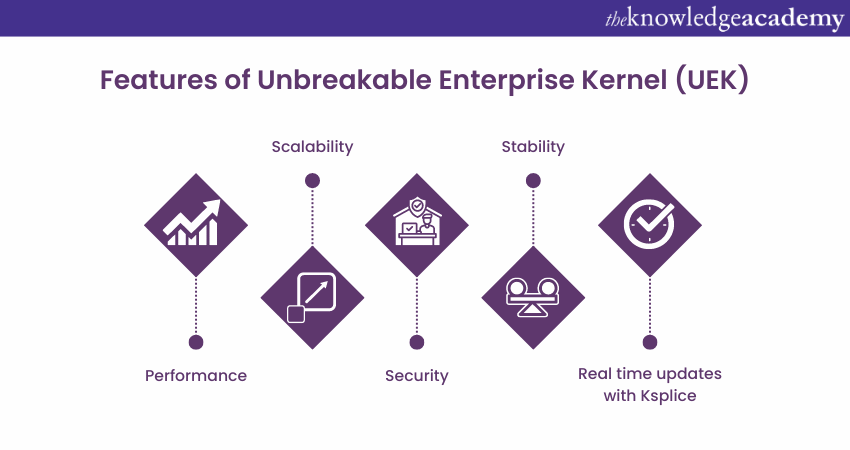We may not have the course you’re looking for. If you enquire or give us a call on 01344203999 and speak to our training experts, we may still be able to help with your training requirements.
Training Outcomes Within Your Budget!
We ensure quality, budget-alignment, and timely delivery by our expert instructors.

IT professionals, business leaders, and individual users exploring efficient operating systems are often actively learning about What is the Oracle Linux Operating System. Oracle Linux is an open-source, enterprise-class operating system developed by Oracle Corporation. It's renowned for its scalability, robustness, and cost-effectiveness.
According to Jetbrain’s 2022 State of Developer Ecosystem Report, over 55 per cent of developers target Linux for desktop development projects. Moreover, with features like the Unbreakable Enterprise Kernel (UEK), Oracle Linux has become a preferred choice for various applications, ranging from personal computing to large-scale enterprise deployments. This blog teaches you about What is Oracle Linux, and how it is an open-source operating system available to users under the GNU General Public License developed by Oracle.
Table of Contents
1) An introduction to What is Oracle Linux
2) Versions and features of Oracle Linux
3) Why Oracle Linux is called the Unbreakable Enterprise Kernel (UEK)
4) Conclusion
An introduction to Oracle Linux
Oracle Linux, developed by Oracle Corporation, is an open-source operating system that's a variant of Linux. Since its release in 2006, Oracle Linux has been tailored to support various applications and systems, particularly those related to business and enterprise environments.
Now one of its defining features is the Unbreakable Enterprise Kernel (UEK), which offers impressive performance and scalability. Security, too, is a strong point for Oracle Linux, with robust measures implemented to meet rigorous enterprise standards.
Additionally, with native support for cloud computing and virtualisation, Oracle Linux seamlessly integrates with other Oracle products, ensuring a cohesive and efficient user experience. It stands apart from other Linux distributions with its alignment to business requirements, consistent updates, and strong community support.
Furthermore, the free availability of Oracle Linux, coupled with optional paid support, makes it a preferred choice for both individual and corporate users. It represents a blend of flexibility, power, and reliability, making it a key player in the modern technology landscape.
More importantly, Oracle Linux is more than just an operating system; it's a strategic asset for anyone looking to harness the power of open-source technology, whether for business or personal use.

Versions and features of Oracle Linux
Here are the past versions of Oracle Linux, listed below as shown:
Past versions of Oracle Linux
1) Oracle Linux 4:
a) Released: 2006
b) Key features: Introduction of Oracle's Unbreakable Linux support program.
c) Enhancements: Focused on support and stability for enterprise applications.
2) Oracle Linux 5:
a) Released: 2007
b) Key features: Based on Red Hat Enterprise Linux 5.
c) Enhancements: Better support for system administration and virtualisation technologies.
3) Oracle Linux 6:
a) Released: 2011
b) Key features: Introduction of the Unbreakable Enterprise Kernel (UEK) for better scalability and performance.
c) Enhancements: Improved file system support and better security features.
4) Oracle Linux 7:
Released: 2014
a) Key features: XFS as default file system, support for Linux Containers.
b) Enhancements: Extends the flexibility, scalability, and reliability of Oracle Linux distributions.
5) Oracle Linux 8:
a) Released: 2019
b) Key features: Incorporation of the Application Stream (AppStream) repository, DNF package manager.
c) Enhancements: Improved support for modern development tools and latest hardware platforms.
6) Unbreakable Enterprise Kernel (UEK) versions:
a) UEK R1: Introduced with Oracle Linux 5.5.
b) UEK R2: Released with Oracle Linux 6, included improved scalability and performance.
c) UEK R3: Enhanced support for file systems, reduced boot time.
d) UEK R4: Support for the latest hardware and virtualisation technologies.
e) UEK R5: Latest version with improved driver support and compatibility with cloud infrastructure.
7) Specialised versions and spins:
a) Oracle VM Server for x86: Virtualisation platform based on the Xen hypervisor and Oracle Linux.
b) Oracle Linux for ARM: Tailored for ARM processors.
Learn the essentials to program with the shell, by signing up for our Linux Training now!
Features of Oracle Linux
Oracle Linux is known for its wide range of features that cater to a broad range of users. Here's a detailed look at the features that make Oracle Linux a strong contender among operating systems:

1) Unbreakable Enterprise Kernel (UEK):
a) Oracle's customised kernel that offers improved performance, scalability, and reliability.
b) Supports the latest hardware and technologies straight out of the box.
2) Open source and cost-effective:
a) While Oracle Linux is open source and free to use, Oracle also offers optional subscription levels, which provide support and other services.
b) Enables businesses to reduce overhead costs while benefiting from a premium OS.
3) Security:
a) Offers Ksplice, a tool that applies patches and updates without needing to reboot the system, ensuring uptime and constant security.
b) Implements robust security measures compliant with rigorous enterprise standards.
c) SELinux and advanced firewall for enhanced security configurations.
3) Compatibility:
a) Based on Red Hat Enterprise Linux (RHEL), ensuring broad compatibility with existing applications designed for RHEL.
b) Certified by third-party vendors ensuring compatibility with various hardware and software solutions.
4) Virtualisation support:
a) Robust support for both Oracle VM and KVM.
b) Offers a cost-effective, integrated solution to manage and monitor virtual machines.
5) File systems:
a) Supports a variety of file systems, including Btrfs, XFS, ext3, and ext4.
b) Offers advanced features like snapshots and rollback for Btrfs.
6) Cloud compatibility:
a) Optimised for Oracle Cloud and Oracle Engineered Systems.
b) Seamless integration with various cloud platforms, ensuring efficiency and performance in cloud environments.
7) DTrace:
a) Dynamic tracing framework that assists in troubleshooting kernel and application problems.
b) Enables in-depth system introspection.
8) Performance and scalability:
a) Ensures optimal application performance by providing a balanced operating system.
b) Tailored for both small-scale and extensive enterprise deployments.
9) Integrated Development Environment (IDE):
a) Includes comprehensive development tools for compiling, debugging, and profiling applications.
b) Supports the latest programming languages and libraries.
10) Container support:
a) Features a container runtime for building and running applications.
b) Integrated with Docker and Kubernetes.
11) Management and administration:
a) Oracle Linux Manager (based on Spacewalk) provides a web-based interface for managing systems.
b) System administration is simplified with utilities like Dandified Yum (DNF).
12) High availability:
Features the Oracle Clusterware for Linux, ensuring service availability.
Incorporates Oracle Linux System Administration, offering high-availability services for crucial applications.
13) Active community and documentation:
a) Oracle Linux is backed by a dedicated community that offers support, shares ideas, and collaborates on solutions.
b) Extensive documentation, online forums, and tutorials facilitate users at all expertise levels.
14) Support and training:
a) Oracle offers 24/7 support for subscribers, ensuring solutions for any arising issues.
b) Oracle University provides courses and certifications on Oracle Linux.
Attain the knowledge to use and interact with LINUX, by signing up for our LINUX Fundamentals course now!
Why Oracle Linux is called the unbreakable Enterprise Kernel (UEK)
Oracle Linux is often referred to as the "Unbreakable Enterprise Kernel" (UEK) due to several distinctive features:

a) Performance:
UEK is optimised for high performance in large enterprise environments, handling substantial workloads efficiently.
b) Scalability:
It's designed to scale effortlessly with business growth, supporting vast numbers of processors, physical memory, and concurrent users.
c) Security:
Integrated robust security measures ensure the protection of data and resources, contributing to its "unbreakable" moniker.
d) Stability:
UEK undergoes rigorous testing and is engineered for reliability, offering a stable environment for critical applications.
e) Real-time updates with Ksplice:
Enables application of patches without system reboots, minimising downtime and maintaining continuous operation.
Conclusion
You have now understood What is Oracle Linux, and how it is a robust, versatile, and efficient operating system tailored for modern enterprises. With features like the Unbreakable Enterprise Kernel, it represents a blend of performance, security, and cost-effectiveness, meeting the diverse needs of individual users and large organisations.
Learn to administer Oracle databases and manage information, by signing up for the Oracle Training now!
Frequently Asked Questions
Upcoming IT Infrastructure & Networking Resources Batches & Dates
Date
 Oracle Database 12c: Administration
Oracle Database 12c: Administration
Mon 2nd Dec 2024
Mon 6th Jan 2025
Mon 20th Jan 2025
Mon 27th Jan 2025
Mon 10th Feb 2025
Mon 24th Feb 2025
Mon 10th Mar 2025
Mon 24th Mar 2025
Mon 14th Apr 2025
Mon 28th Apr 2025
Mon 12th May 2025
Mon 26th May 2025
Mon 2nd Jun 2025
Mon 16th Jun 2025
Mon 7th Jul 2025
Mon 14th Jul 2025
Mon 28th Jul 2025
Mon 11th Aug 2025
Mon 25th Aug 2025
Mon 15th Sep 2025
Mon 29th Sep 2025
Mon 20th Oct 2025
Mon 3rd Nov 2025
Mon 17th Nov 2025
Mon 1st Dec 2025
Mon 15th Dec 2025







 Top Rated Course
Top Rated Course


 If you wish to make any changes to your course, please
If you wish to make any changes to your course, please


